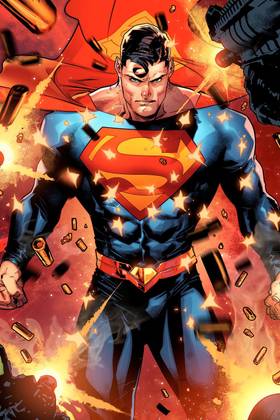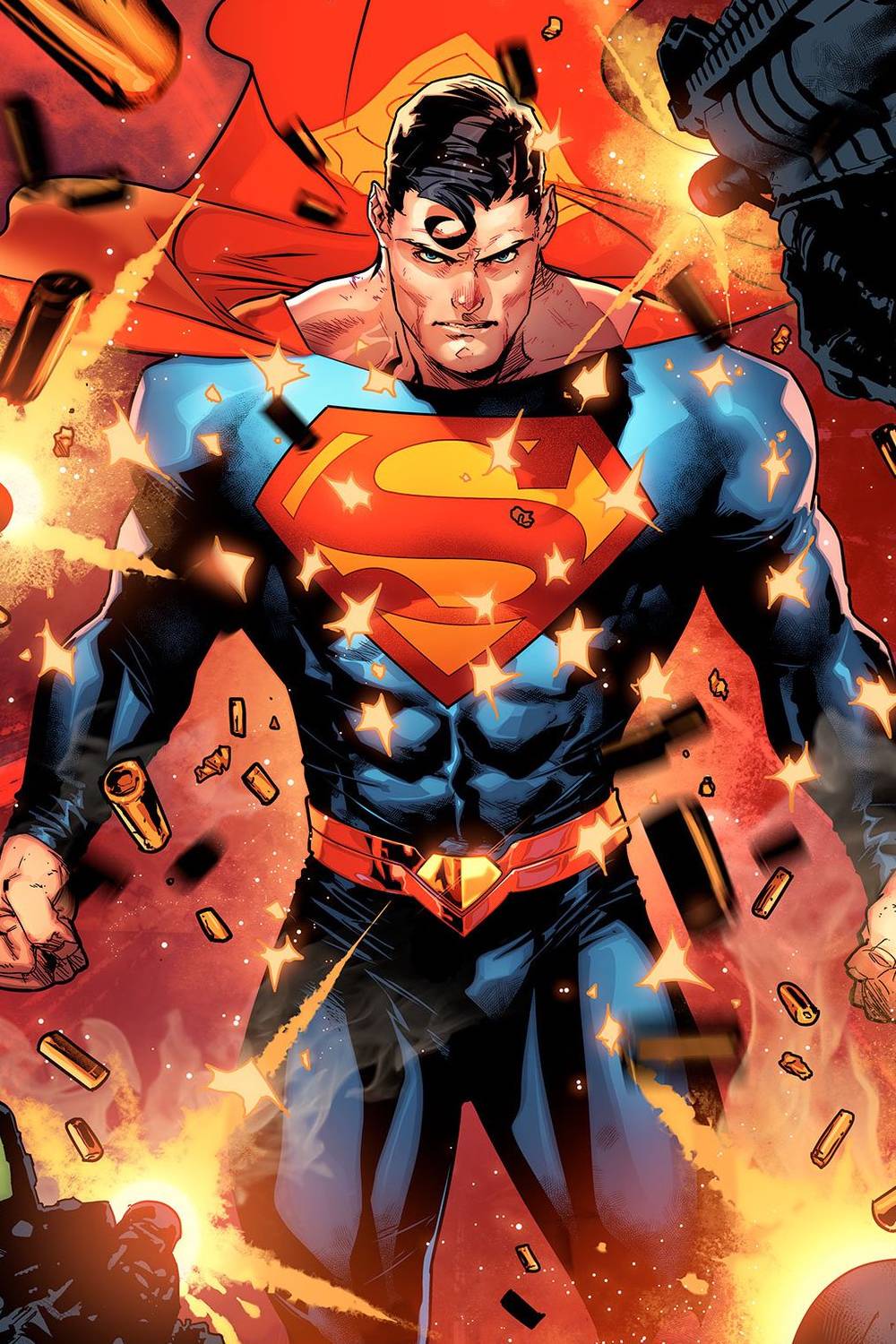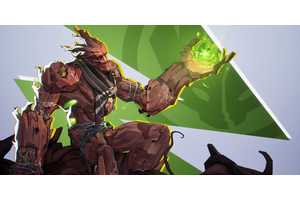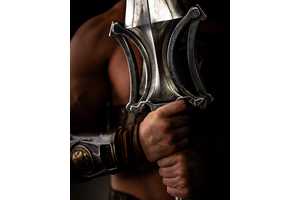Up and Away: Ranking Superman's 10 Best Reboots to Date
In the decades since DC published Crisis on Infinite Earths, Superman has had a number of high-profile reinventions, reboots, and retoolings. With another on the horizon as part of Dan Slott's much-anticipated trip to Superman's city, it's as good a time as any to look back on what's come before, what stories did the most to change (or reset) the Man of Steel's history, and what those stories might say about the future.
The practice of rebooting superheroes - or, indeed, thinking about continuity - only took hold decades after Superman was created, so there are few Man of Steel reboots that came before John Byrne's seminal mid-'80s Superman run. By including continuity tweaks and seismic status quo shifts into the definition of "reboot," the Superman character has been through some major changes in his character and world over the course of his eight-decade publication history.
10 Superman Forever #1 (1998)
By Louise Jones Simonson, Karl Kesel, Stuart Immonen, Dan Jurgens, Jon Bogdanove, Dick Giordano, Norm Breyfogle, Kieron Dwyer, Anthony Williams, Val Semeiks, Paul Ryan, John Byrne, Steve Yeowell, Tom Grummett, Scot Eaton, and Many More
The "Electric Superman" era got a raw deal, but the end of that era was unambiguously kind of a mess. With red and blue versions of Superman, the creative teams had to figure out not just how to re-merge Clark's two halves, but also restore his original appearance and powers. The mini-crossover that set up the Superman Forever one-shot, in which the Supermen and their allies did battle with the "Millennium Giants," was underwhelming, and when it finally came time to restore Superman's classic look, so was Superman Forever.
It was also, obviously, nice to see Superman back to normal after an extended period in one of his more gimmicky transformations.
That isn't to say the book was all bad, as the creative teams who were on the various Superman titles at that time were terrific, and so it was a great-looking book. It was also, obviously, nice to see Superman back to normal after an extended period in one of his more gimmicky transformations. Still, the lack of explanation as to how and why things changed to begin with, and the relatively "blah" threat of the Millennium Giants, all came together to make the story feel kind of pointless. It's almost like Clark could have just changed back at random.
9 Doomsday Clock (2017)
By Geoff Johns, Gary Frank, Brad Anderson, and Rob Leigh
Before making some of the best comics in years with his Image imprint Ghost Machine, writer Geoff Johns tackled legacy, continuity, and philosophy in the bizarre Watchmen pseudo-sequel Doomsday Clock. "Bizarre" isn't necessarily an insult here, as the book - created with Gary Frank - had some really high highs. But in the end, it felt like most of the deep thinking Johns was doing fell apart, and Doomsday Clock became just another continuity-altering event in the vein of Infinite Crisis or Zero Hour: A Crisis in Time.
In Doomsday Clock, DC introduced the metaverse: the idea that the multiverse as we previously knew it has been secretly evolving over time, roughly in step with Superman. That explains every reboot in the Man of Steel's history and many more changes, retcons, and rolls of the timeline. Like Johns's approach to Hawkman, this approach is meant to be applyied not just to what has come before, but towhat comes ahead. The issue is that the story really only matters to the kind of fan who obsesses over continuity. A lot more comic fans than other forms of entertainment care about continuity, but it's still a fairly niche segment of the audience.
8 The So-Called "Silent Reboot" (1969)
A Silver Age Shift in the Multiverse
As alluded to above, while there were certainly overarching stories that carried from book to book, many of the early superhero comics were meant to be easy to pick up and drop. One-and-done stories were more or less the norm in the early days of American superhero comics, and DC didn't get really serious about having a "continuity" or "canon" until the advent of the Silver Age in the late 1950s and early '60s - which also led to the debut of Earth-2 and DC's earliest multiverse.
The beloved Superman Family character Power Girl also famously comes from Earth-2!
At some point in the early days of the Silver Age, DC decided that the Golden Age Superman - the one who leaped tall buildings, fought wife-beaters, and first appeared in 1938 - was in fact the version from Earth-2, and that the monthly adventures of Superman had kicked over to covering the Superman of Earth-1 at some point. While Silver Age versions of former Justice Society heroes like the Flash and Green Lantern started appearing by the end of the 1950s, it wasn't until 1969 that Kal-L was finally established as distinct from Kal-El, and most of his early adventures were assigned to Earth-2.
7 Absolute Superman #1 (2024)
By Jason Aaron, Rafa Sandoval, Ulises Arreola, and Becca Carey
DC's Absolute Universe is one of the most ambitious publishing initiatives the publisher has undertaken in the last 20 years, and Superman is right at the center of it. The Absolute Universe gives fans a darker, more modern look at iconic DC characters, all set in a world overcome with "Darkseid energy." It is not exactly clear whether these versions of the characters will stick around in the long term, like Marvel's Ultimate Universe, but the fan and critical reception has been overwhelmingly positive.
The Absolute Universe version of Superman is a radical new take on the Man of Steel - but one that stays true to the character's origins as a "Champion of the Oppressed," as he was originally called in 1938's Action Comics #1. In this world, Superman roams the Earth with volatile powers, protecting working class laborers. In flashbacks, readers learn that Kal-El actually got the chance to grow up on Krypton with his parents, who were also laborers, barred from the ruling science class. In its early issues, Absolute Superman promises to be a new take on the character that fans will talk about for years to come.
6 The New 52 (2011)
Action Comics #1 by Grant Morrison and Rags Morales; Superman #1 by George Pérez and Jesús Merino
In 2011, DC announced that it would reboot its publishing line, restarting every book at #1, canceling some titles and launching or relaunching others. With 52 new #1 issues to choose from, DC overtook Marvel as the biggest seller in comics - something that rarely happens - and it held onto that position for months. There was initial enthusiasm for the relaunch, but it was mingled with frustration, doubt, and confusion as DC declined to clarify exactly how thorough their reboot was going to be, and what stories might still "count," especially for its oldest characters - like Superman.
The New 52 also featured radical reboots for characters and teams like Wonder Woman, the Flash, and the Justice League, though Batman and the Bat-Family largely stayed the same.
DC's Superman books were among the titles that struggled the most. While fans and critics enjoyed Grant Morrison's take on the Golden Age Superman in Action Comics, George Pérez almost immediately started having creative differences with DC and left the title. After Keith Giffen and Dan Jurgens took over, it wasn't long before they, too, were ready to leave the book. The New 52 Superman's costume was marketing-friendly outside of comics but widely hated by longtime fans, and the erasure of the Superman and Lois Lane marriage (which had been in place since the late 1990s) irritated some readers, too.
5 Rebirth (2016)
Superman: Rebirth #1 by Peter J. Tomasi, Doug Mahnke, Jaime Mendoza, Wil Quintana, and Rob Leigh
After DC's New 52 initiative fizzled, the publisher tried to revive interest in its stories by blending elements of the New 52 with aspects of the pre-Flashpoint DC Universe. That yielded the DC's Rebirth era, which restored a number of classic status quos. It also took two versions of Superman - the New 52 version and the post-Crisis version - and merged them together into one, definitive version of the Man of Steel going forward.
Unlike the New 52, where Action Comics and Superman took place years apart and didn't seem to mesh, the delineation between Dan Jurgens and Patrick Zircher's Action Comics and Peter J. Tomasi and Patrick Gleason's Superman were pretty clear-cut. The former was a return to form for classic Superman stories, and the latter took place on the Kent farm, where Clark and Lois were raising Jonathan Kent and teaching him how to use his newly-discovered powers. It was an exciting time to be a Superman fan and has been the standard for Superman storytelling since.
4 Superman: Birthright (2003)
By Mark Waid, Leinil Francis Yu, Gerry Alanguilan, Dave McCaig, and Comicraft
These days, fans mostly discuss Superman: Birthright as the comic that brought the post-Crisis era of Superman closer in line with Smallville, the hit TV series that was airing at the time. There's an element of truth to that, of course, but writer Mark Waid had been trying to get his hands on a Superman book since at least 1999, when he was one of the architects of the failed Superman 2000 pitch.
In Birthright, Waid and Leinil Yu explore Clark's early years, playing nicely with Byrne's version of history for the most part, but softening some of Krypton's sterile, sci-fi edge. The series reshaped Superman for about a decade, until Secret Origin came along and once again fine-tuned things. It's one of the best-received stand-alone Superman series, whereas moments of Superman histroy like the Rebirth and the New 52 ea were more open-ended, and thus less structured.
3 Convergence: Superman (2015)
By Dan Jurgens, Lee Weeks, Norm Rapmund, Brad Anderson, and Sal Cipriano
Convergence was one of a number of DC events that were placed more or less back-to-back, with the express goal of getting things "back to normal" once it became clear that the New 52 had run its course. In the story, which leads almost directly to Rebirth, a number of cities from DC's multiverse were "collected" by Telos, a harbinger of Brainiac, and stranded on a world where nobody's superpowers worked.
During their time without powers, Clark and Lois start a family, and Jon Kent is delivered by Dr. Thomas Wayne (of Flashpoint fame). The story reveals something important: this pregnant Superman and Lois are the Superman and Lois that fans had been following from Crisis on Infinite Earths until Flashpoint. With their marriage restored and with the verification they were alive, the characters made their way to the DC Universe and eventually merged with their New 52 counterparts. Before that, they starred in the Superman: Lois & Clark miniseries, which stands as one of the best in-continuity Superman stories of the last 15 years.
2 Superman: Secret Origin (2009)
By Geoff Johns, Gary Frank, Jon Sibal, Brad Anderson, and Steve Wands
Johns and Frank - who later created Doomsday Clock - provided longtime fans with exactly what they had wanted since the 1980s: a version of the post-Crisis on Infinite Earths Superman story that also embraced some of the missing elements of the pre-Crisis era, like Clark acting as Superboy and having a meaningful relationship with the Legion of Super-Heroes.
More than any book since The Man of Steel, Secret Origin also felt new reader-friendly...
Secret Origin was an attempt at bringing Birthright into line with John Byrne's The Man of Steel, plus setting up what Johns had in mind for what would become a fan-favorite run on Action Comics. More than any book since The Man of Steel, Secret Origin also felt new reader-friendly, introducing even its biggest, wildest concepts like the Legion with the kind of entry-level savvy that would help Johns become a best-seller in the bookstore market. Frank's art, of course, was top-notch, and he had plenty of opportunities to showcase his versatile and thoughtful approach while tackling everything from high school romances to interstellar conflicts.
1 The Man of Steel (1986)
By John Byrne, Dick Giordano, Tom Ziuko, and John Costanza
John Byrne's The Man of Steel was the first major and officially recognized Superman reboot, and it remains the best and most satisfying of the lot. Over the years, Superman's story had been added to by various writers and artists, mostly to play a role in whatever stand-alone story was happening at the time. Byrne reinvented the world of Superman in a way that created a holistic mythology for the first time.
When DC's multiverse became too unwieldy for casual readers (and some editors) to keep track of, the publisher launched Crisis on Infinite Earths by Marv Wolfman and George Pérez, a massive crossover that ended the multiverse for two decades as well as merge DC's main timeline with a number of alternate earths featuring fan-favorite characters from the past (or other publishers). The publisher also took the opportunity to respond to the common criticism that Superman was too powerful and not "human" enough, scaling his powers back and giving him a more rounded personality that felt less like a "costume" he put on.
Following The Man of Steel, it was more than a decade before DC felt the need to do a serious tweak to Superman again (with Birthright), and during that time, the character enjoyed some of his biggest commercial success in decades, with The Death and Return of Superman, the "Electric Superman" saga, and a number of other hit stories that continue to sell in reprints to this day.

- Created By
- Joe Shuster, Jerry Siegel
- First Appearance
- Action Comics
- Alias
- Kal-El, Clark Kent, Jonathan Kent
- Alliance
- Justice League, Superman Family
- Race
- Kryptonian
- Franchise
- D.C.







